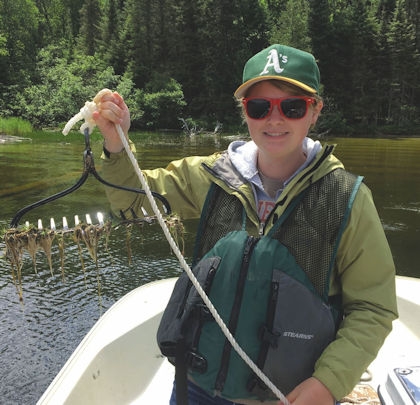
Protect Your Shoreline With An Itasca Waters Shoreland Advisor
Learn MoreThe hunt for missing water quality data
by Sally Sedgwick
for the Itasca Water Legacy Partnership
What most of us notice when we’re out on the lake is whether the water is clear.
But underlying that clarity is lake quality data – pH, phosphorus content and more. In fact, lake water quality data is used for all sorts of reasons – doing research, making policy, forecasting trends and developing water plans, explained Moriya Rufer, aquatic ecologist with RMB Environmental Laboratories (RMBEL) headquartered in Detroit Lakes.
Over the past few decades, lake data has been collected on and off by volunteers on many of the 1,084 lakes in Itasca County. Much of that data is in the public water database kept by the Minnesota Pollution Control Agency, where it can be accessed by anyone.
Last year the Itasca County Soil and Water District was working with RMBEL to update the county water plan. While using the public data and checking with lake associations, they discovered a curious thing. Not all the data collected had found its way to the state database.
At the local level, lake associations they contacted knew of other data or other years that data had been collected. Driven by local concern, lake associations had created their own volunteer monitoring programs and used different labs throughout the state to process samples. Some of that data had stayed in files kept locally.
The Itasca Water Legacy Partnership, a volunteer group which seeks to preserve the county’s water quality, decided to do something about the gaps in accessible data. Together with RMBEL, which is donating staff hours to the project, they are sponsoring a project to go through the process of contacting each lake association and setting up meetings to look over the data that is currently in the state database and find any missing data to complete the record. The end product will be a report readily available and easily understood by the lay person who wants more information about a particular lake.
 The project is coordinated by Rufer and is expected to be completed by the end of 2016. Anna Johnson from the Grand Rapids RMBEL lab located on the Itasca Community College campus has been contacting each lake association in the county during September 2016.
The project is coordinated by Rufer and is expected to be completed by the end of 2016. Anna Johnson from the Grand Rapids RMBEL lab located on the Itasca Community College campus has been contacting each lake association in the county during September 2016.
“Volunteers have put a lot of time into helping collect the data,” Rufer pointed out, “so it’s good to be able to have this data available for reports and planning documents.”
IWLP was organized in 2009 to form partnerships and create awareness about the remarkable water quality experienced in Itasca County, and the efforts needed to preserve that water quality.
To date, IWLP has partnered in $1.5 million in grants for projects and partnered with a variety of organizations including national, state and county agencies. Among those projects underway and completed are control of and education about aquatic invasive species, ensuring availability of local water quality testing, identifying sensitive lakeshore and establishing the economic value of water resources in Itasca County.
The mission of IWLP is to "Team Up" with other organizations and concerned citizens to maintain abundant, clean water for our continued health, enjoyment and a strong economy. IWLP is a nonprofit made up of volunteers interested in its mission in preserving water quality within the county and welcomes prospective members.


